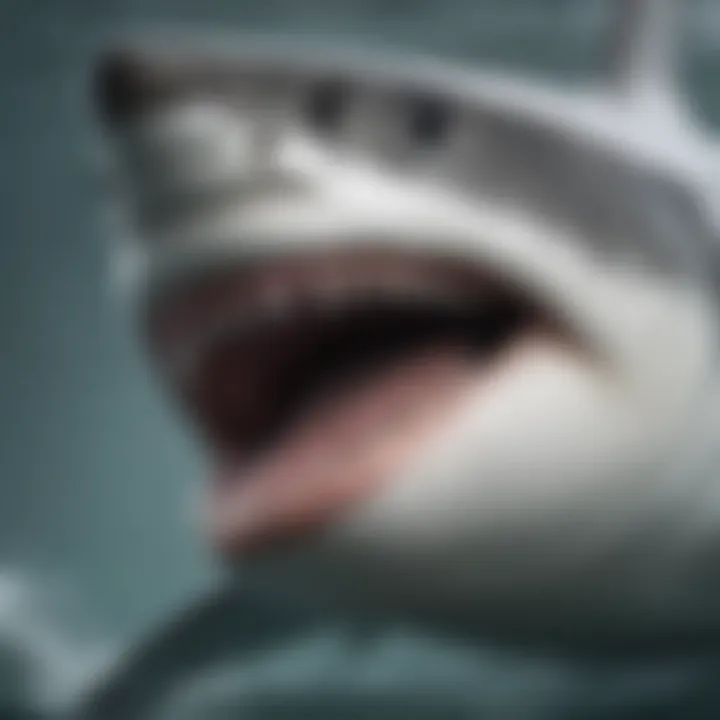Exploring the Sleep Patterns of Great White Sharks


Intro
The great white shark, a true titan of the ocean, has long captivated the human imagination and scientific inquiry alike. Their physical prowess and predatory finesse are well known, yet what about their sleep patterns? Despite being apex predators, great whites exhibit complex behaviors when it comes to rest and activity cycles. Understanding how these magnificent creatures manage their rest is not just academically intriguing, but also crucial for marine conservation efforts.
In this inquiry, we will explore the unique physiological adaptations of great white sharks that facilitate their sleep. These adaptations not only influence their ability to rest but also how they navigate the vast and sometimes perilous underwater environment.
Key Points
- The physiological traits that affect sleep behavior in great white sharks.
- The correlation between sleep patterns and survival in marine ecosystems.
- Implications for conservation and understanding shark behaviors amid environmental changes.
Tapping into marine biology research, we will unveil the intricacies of how these giants of the deep rejuvenate while still being effective hunters. The objective is to bridge the gap between shark behavior and the broader ecological context, ultimately highlighting the importance of preserving their habitats and populations. Let's plunge into this fascinating world beneath the waves.
Prelims to Shark Behavior
Understanding shark behavior is crucial NOT just for marine biologists but also for surfers, beach lifeguards, outdoor writers and other enthusiasts who share oceans with these magnificent creatures. When we have a grasp on how sharks operate, particularly their sleep and rest patterns, we can promote safer interactions between humans and the ocean's natural predators.
Great white sharks, specifically, have evolved intricate physiological mechanisms over millions of years. By acknowledging these mechanisms, we can discern their energetic needs, social interactions, and even their predatory tactics. This knowledge becomes invaluable when considering conservation tactics. After all, safeguarding these apex predators ensures the balance of marine ecosystems.
Why Study Shark Behavior?
- Safety and Awareness: Understanding the behaviors of sharks helps in preventing accidents and fostering coexistence.
- Conservation Efforts: Insight into sleep patterns and behaviors can aid strategies to protect shark habitats.
- Ecosystem Health: Recognizing how sharks interact with their prey contributes to understanding broader ecological dynamics.
Understanding shark physiology allows us to delve deeper into their world. This opens the path to addressing how they adapt and respond to environmental challenges. The better we understand them, the more informed our conservation efforts will be, ultimately benefiting both sharks and humans.
Defining Sleep in Marine Creatures
Understanding sleep in marine creatures, particularly in sharks, provides an essential window into their behavior and ecology. It is not merely an absence of activity; instead, sleep is a complex physiological state necessary for survival. In the context of great white sharks, defining sleep helps in unraveling the mysteries surrounding how these formidable predators manage energy, learn from their environment, and maintain their health in the ever-challenging ocean.
Characteristics of Sleep
When it comes to the characteristics of sleep, marine species display various adaptations that reflect their environment's demands. Unlike terrestrial animals, marine creatures often sleep in a way that allows them to remain alert to predators or prey. Notable features include:
- Behavioral Adaptations: Certain species can "rest" one hemisphere of their brain while the other remains active. This is particularly pronounced in sharks, where they must continue swimming to breathe, as they rely on water flowing over their gills.
- Vigilance: Sleep may not be as deep as seen in land animals. Sharks can exhibit a state where they're less responsive but still aware of their surroundings, allowing them to react to potential threats or opportunities.
- Diverse Patterns: Different species demonstrate unique sleeping habits. For instance, some may rest on the ocean floor, while others maintain slow swimming speeds, demonstrating highly adaptable sleep patterns tailored to their lifestyles.
In essence, sleep is not a simple darkness for these animals; it’s an essential part of their survival toolkit.
Sleep Research in Sharks
Research surrounding sleep in sharks is burgeoning. Although it may not be as extensive as studies conducted on terrestrial mammals, emerging data highlights intriguing aspects of their sleep behavior.
- Initial Investigations: Studies have indicated that great white sharks may engage in forms of rest that are inherently different from those of some other species. For example, they often remain in a state of semi-consciousness, which enables them to filter sensory input while still executing necessary functions like swimming.
- Methodologies Used: Technological advances, such as using accelerometers and tracking systems, are instrumental in monitoring shark behaviors. Researchers can analyze movement patterns to assess resting phases, which usually involve noticeable periods of reduced activity beneath the surface.
- Implications of Findings: Understanding how sharks enter states of rest has broader implications for marine biology. It contributes to the knowledge of how these apex predators interact with their environment and may inform conservation strategies, especially as human activities encroach on their habitats.
The study of sleep in sharks, while still an emerging field, promises insights that could reshape our understanding of these complex creatures, offering implications well beyond simply the act of resting.
Sleep Mechanisms in Great White Sharks
Understanding the sleep mechanisms of great white sharks is pivotal in grasping their overall behavior and survival strategies. Unlike warm-blooded animals, great whites exhibit unique adaptations that enable them to rest while still remaining alert to their surroundings. This section will delve into the various aspects of their sleep mechanisms, highlighting the significance of these patterns amidst their predatory lifestyle.


Unilateral Sleep Patterns
Great white sharks display what is termed as unilateral sleep, a fascinating and somewhat unconventional sleeping arrangement. This means that instead of fully shutting down for an extended period, they often rest one hemisphere of their brain at a time. Essentially, one side sleeps while the other remains awake and attentive to potential threats, ensuring they can swim to safety if necessary.
This adaptation serves a crucial purpose. For sharks, being in a constant state of readiness is essential given their position in the marine ecosystem. Experiencing sleep through unilateral patterns allows them to conserve energy while still being able to navigate their environment and hunt effectively. Biological studies suggest that this method of sleeping may help mitigate risks associated with predation and environmental hazards, giving sharks a leg-up in their survival game.
In practical terms, this means while a part of their brain is resting, the shark can still pump water through its gills and continue swimming. They often favor currents to help them move with less effort, even when resting. The efficiency of this dual-wake state leads to discussions about the evolutionary advantages of such sleep strategies in the animal kingdom.
"Sharks are the sentinels of the sea; their sleep behaviors reflect a masterful adaptation to a life where vigilance is key."
Respiratory Adaptations
Another crucial aspect of sleep mechanisms in great white sharks relates to their respiratory adaptations. Unlike mammals that breathe automatically, these sharks must actively swim to ensure a steady flow of water over their gills. This brings about a significant challenge when considering their unique sleep patterns.
To tackle this, great whites have adapted fascinating techniques. The first is their ability to use a method called buccal pumping. This means they can draw water into their mouth and push it over their gills even while somewhat stationary. Although they still need to swim, they can maintain a lower level of activity while achieving respiration during their rest periods.
Additionally, studies indicate that great whites exhibit varied patterns of movement during sleep and rest phases. Some may engage in gentle gliding paired with limited movement to reduce metabolic costs. Others have been observed using the ocean currents to maintain momentum. These adaptations not only contribute to their resting behavior but underscore the intricate connection between their anatomical features and their ecological roles.
In summary, understanding the sleep mechanisms of great white sharks is vital for comprehending how they operate in their underwater domain. The combination of unilateral sleep patterns with clever respiratory strategies underscores their evolutionary prowess, positioning them as effective predators within their ecological niche.
Understanding Shark Movement During Rest
Understanding the movement patterns of great white sharks during their rest phases is critical for several reasons. First off, it sheds light on how these apex predators maintain their physiological needs in the dynamic and often volatile marine environment. Unlike many creatures that can simply find a safe spot to sleep, great whites have to keep moving to ensure they can breathe and, at the same time, hunt for food. This adds a level of complexity to their rest behavior that is both fascinating and essential to their survival.
The Role of Swimming in Breathing
For sharks, the act of swimming is not merely about mobility; it’s a physiological necessity. Great white sharks rely on a process called ram ventilation, which involves swimming with their mouths open to push water over their gills. When a shark stops swimming, it risks suffocation because water won’t flow through its gills effectively. Thus, even during periods of rest, they need to stay in motion, albeit at a slower pace.
- Physiological Adaptations: The anatomy of a great white shark is fascinating. Their bodies are streamlined for efficiency, allowing them to glide through water with minimal effort. Their pectoral fins are angled down, which helps maintain their forward motion with less energy expenditure even when they're resting.
- Breathing Patterns: Interestingly, studies have shown that sharks can modify their swimming patterns to conserve energy when they are resting. They might swim in circles or at a slower speed, allowing their bodies to recuperate while still taking in the necessary water for respiration.
- Energy Management: For great whites, being selective about their movements can mean the difference between survival and failure when hunting. Thus, this swimming behavior demonstrates a crucial survival instinct, optimizing their energy use during rest.
Behavioral Modifications During Rest
When discussing the behavioral modifications of great whites during their resting periods, one can’t overlook the adaptive strategies they employ to balance rest with environmental threats. These modifications are crucial for their continued existence in a habitat full of potential dangers.
- Alertness and Awareness: Even in a state of rest, great white sharks maintain a level of vigilance. They utilize half of their brain to monitor their surroundings, which is an evolutionary trait known as unilateral brain function. This adaptive behavior allows them to stay alert to threats while still enabling necessary respite.
- Positioning: Sharks often adjust their body positions to optimize their movement even when resting. They may hang in the water column or rest on the ocean floor while still moving slightly, utilizing the natural currents to help maintain their oxygen intake. This behavior illustrates a remarkable level of resourcefulness.
- Social Behavior: Sometimes, these animals exhibit changes in behavior based on the presence of other sharks or species. If another predator appears, a resting shark can quickly re-engage with the environment or adopt more active swimming behaviors to avoid any dangers.
"Understanding movement and behavior during rest is vital for conservation efforts and for maintaining a healthy ecosystem."
By looking closely at how great white sharks manage their movement during rest and employing various strategies, researchers can gather essential insights that contribute not only to marine biology but also to the conservation and protection of these magnificent creatures. This understanding ultimately ties back into the broader context of marine health and the balance of ocean ecosystems.
Ecological Context of Great White Sharks' Sleep
Understanding the ecological context of great white sharks' sleep is vital for grasping their overall behavior and survival strategies. These sharks occupy a unique niche within the marine ecosystem, and their sleep patterns reveal how they adapt to environmental pressures while ensuring their survival. The ecological aspect is interwoven with aspects such as predator-prey relationships, environmental changes, and competition for resources.
Sharks, particularly great whites, exhibit fascinating adaptations that relate directly to their sleep environments. Their sleep patterns, influenced profoundly by the surrounding seas and the presence of prey or predators, reflect how these creatures have evolved to thrive. Knowing about their sleeping behavior isn’t just an academic exercise; it also holds significant consequences for conservation efforts.
Impact of Environmental Factors


Environmental factors play a crucial role in the resting behavior of these formidable predators. The ocean is not static; it is a dynamic and often turbulent habitat. Various elements, including water temperature, light, and the availability of prey, can influence when and how long great white sharks rest. For instance:
- Water Temperature: Great whites tend to prefer warmer waters, which can ripple through their physiological needs. These preferences shape their migratory patterns and influence their feeding success.
- Light Levels: During the day, visibility can impact both predator and prey behaviors. Great whites may adjust their sleep cycles based on the time of day, opting for more active periods when their hunting is most effective.
- Prey Availability: The presence or absence of prey can dictate resting behaviors. For example, during times of abundant seals, great whites might engage in shorter, lighter sleep sessions, staying alert for feeding opportunities.
As a result, it's clear that their sleep is not an isolated behavior, rather it is entrained within a complex web of ecological interactions, signaling how these apex predators have evolved in response to their surroundings.
Predator-Prey Dynamics
Likewise, the interactions between predators like great white sharks and their prey play a significant role in shaping their sleep behaviors.
- Hunting Strategies: When great whites are in regions with high prey density, their activity levels increase. In such cases, they may reduce their sleeping time to maximize hunting efficiency, highlighting a delicate balance between energy conservation and the need for sustenance.
- Competition: The presence of other predators can alter their resting behavior. If competing species are in the vicinity, great whites may alter their sleep patterns to become more vigilant.
- Safety in Numbers: Interestingly, groups of sharks sometimes exhibit synchronized behaviors during times of rest or alertness. This highlights the social aspect of their ecological interactions and how pair or pack dynamics can influence their individual sleep habits.
In summary, the ecological context of great white sharks' sleep invites a closer examination of not only their behavior but also the intricate relationships they maintain within their marine environment. Understanding these elements helps create a fuller picture of their life and survival, ultimately aiding conservationists in their effort to protect this iconic species. The well-being of these sharks is not just about protecting a single species; it’s about maintaining the health of the entire marine ecosystem.
Research Findings on Shark Resting Behavior
Understanding the resting behavior of sharks, particularly great white sharks, is pivotal in shedding light on their overall biology and ecology. Research in this field captures not only the patterns of rest but also uncovers how these fascinating creatures manage to thrive in the ocean's depths. This knowledge is essential for developing effective conservation strategies and enhancing our comprehension of marine ecosystems.
Studies on Sleep Duration
Current studies on sleep duration in great white sharks emphasize the intricacies of their resting behavior. Unlike many other animals that exhibit a clear sleep cycle, sharks present a more flexible pattern. Some reseachers found that great whites can spend up to 12 hours a day in a state akin to sleep while remaining vigilant to their surroundings. This adaptation allows them to continue swimming, which is vital for oxygen retrieval and avoiding predation.
Several key insights have emerged from these studies:
- Extreme Adaptability: Great whites can adjust their sleep duration based on environmental factors such as water temperature and prey availability.
- Unilateral Resting: They have been observed utilizing unilateral sleep, where one hemisphere of the brain sleeps while the other stays alert, showcasing their unique adaptations for survival.
- Vigorous Activity: Remarkably, periods of deep rest do not diminish their ability to engage in vigorous hunting activities following these phases, asserting their status as apex predators.
Technological Advances in Shark Research
The realm of marine biology keeps evolving, and with it, the tools used to study the sleeping habits of sharks. The introduction of sophisticated technology has transformed our understanding of shark behavior. For instance, researchers are employing underwater cameras and tracking devices to gather real-time data on the movements and rest patterns of great whites. These devices can record their swimming behavior and responses to various stimuli, providing critical insights that were previously impossible to obtain.
Some prominent technological advances include:
- Biotelemetry: This technique allows scientists to monitor the physiological parameters of sharks remotely, giving insight into their resting and active phases.
- Automated Imaging Systems: These systems provide high-resolution footage that helps identify resting behaviors and interactions with the environment.
- Data Analysis Software: The advancements in AI and machine learning enable the processing of vast amounts of data, leading to refined understanding of behavioral patterns over time.
In summary, research concerning shark resting behavior is crucial for recognizing the broader ecological roles of these impressive creatures. A deeper dive into their sleep habits offers not just fascination but also vital conservation implications.
Conservation Implications of Sleep Studies
Understanding the sleep patterns of great white sharks reveals critical insights into their overall health and survival strategies. The significance of studying these behaviors extends beyond mere curiosity; it touches on the core aspects of marine conservation and species protection. By examining how great whites manage their rest and activity, we can assess their vulnerability in changing environments and the repercussions of human influence.
Firstly, knowing how great white sharks sleep allows researchers and conservationists to better appreciate the specific habitats they utilize during these periods of rest. These habitats are often influenced by environmental factors like temperature, food availability, and the presence of predators. Protecting these areas ensures that sharks have safe havens to recuperate, which is crucial for their long-term viability. Additionally, since sleep plays an integral role in behavioral and physiological health, any disruption can have cascading effects on their hunting efficiency and reproductive success.
Another important consideration is the impact of habitat disruption on the shark's ability to maintain their unique sleep patterns. As coastal areas face increased development and pollution, the marine ecosystems that provide crucial resources for great whites might be compromised.
"Habitat loss can substantially influence the sleep behavior of marine creatures, threatening their adaptability and survival rates," highlights a study published in the Journal of Marine Biology.
Addressing Habitat Disruption


Habitat disruption remains one of the pressing issues that threaten not only great white sharks but marine life more broadly. Factors like coastal development, urban expansion, and increased boat traffic can significantly alter the natural landscapes that sharks rely on for both rest and foraging. When these areas become less accessible, great whites may have to expend more energy traveling distances to find suitable spaces to rest, leading to increased stress and decreased survival rates.
As a response to this jeopardy, marine conservationists advocate protecting critical habitats through the establishment of marine protected areas (MPAs). These designated zones help shield vulnerable species during crucial life stages, all while promoting biodiversity.
Some effective strategies for addressing habitat disruption include:
- Implementing strict regulations on coastal development.
- Reducing pollution and human activity in critical transitional zones.
- Encouraging sustainable fishing practices that minimize bycatch.
Policies for Shark Protection
On a policy level, ensuring concrete protections for great white sharks is imperative in mitigating threats posed by habitat changes. Effective shark conservation policies should incorporate the latest research findings on their sleep behaviors and habitat requirements. These policies will not only enhance protection but also foster public awareness.
Broad strategies could encompass:
- Legislation for Marine Protected Areas (MPAs): Enforcing designated safe zones where great whites can thrive without the threat of human encroachment is crucial.
- International Cooperation: Since great whites traverse vast distances and international waters, global collaboration efforts can ensure cohesive protection measures across borders.
- Education and Engagement: Programs aimed at informing local communities and beachgoers about the importance of sharks promote a culture of coexistence and respect for these apex predators.
Future Research Directions
Understanding the sleep patterns of great white sharks opens new avenues for research that can significantly enhance our comprehension of marine biology and ecology. As apex predators, great white sharks play a crucial role in maintaining the balance of marine ecosystems. Thus, insights into their resting behaviors can inform conservation efforts and policy-making, particularly in light of environmental changes and threats from human activity.
Gaps in Current Knowledge
Despite ongoing studies into shark behavior, significant gaps remain in our understanding of how great white sharks sleep, especially in relation to the intricacies of their social and ecological environments. Some of the key areas that warrant further investigation include:
- Duration and Quality of Sleep: Quantifying exactly how much sleep these sharks get is vital. We know that their sleeping patterns are likely different from other marine species, but concrete data is still lacking.
- Impact of Environmental Stressors: How factors like temperature shifts, water pollution, and noise pollution affect sharks’ resting behaviors control much of their health and thus ecosystem balance.
- Behavioral Variability: Different individual sharks might exhibit a range of sleep patterns based on their age, health, and environmental pressures. Understanding these variances can be beneficial for species management.
Highlighting the importance of these gaps can steer future studies in a direction that could yield valuable insights. As noted by marine biologists, "Without addressing what we don't know, we can't make informed decisions for conservation and management."
Potential Research Methodologies
To bridge the gaps in our current understanding, several innovative research methodologies could be employed. They will require collaboration among various disciplines within marine science to ensure holistic assessments of shark behavior. Here are some promising methodologies:
- Telemetry Studies: By using satellite tags and underwater drones equipped with sensors, researchers could track the movement and behaviors of great white sharks in real-time. This would offer insights into their sleeping habits while considering their natural behaviors.
- Sleep Monitoring Technologies: Advances in biomonitoring could allow scientists to examine the physiological metrics relating to sleep, evoking research methods similar to those used in terrestrial animal studies. For instance, utilising accelerometers can reveal when a shark is at rest versus in active state.
- Controlled Experiments: Setting up semi-controlled environments in aquatic research facilities can help in analyzing how great whites react to various stimuli during their rest phases, providing a clearer understanding of their adaptability.
- Multidisciplinary Collaborations: Engaging marine ecologists, conservationists, and behavioral scientists can help enrich studies, creating well-rounded perspectives on how great whites interact with their environment during sleep and waking periods.
As we push forward into deeper waters of understanding, it becomes increasingly clear that a multi-faceted approach will be crucial in piecing together the complex lives of great white sharks.
Ending
In the context of great white sharks, understanding sleep patterns transcends mere curiosity. It presents a gateway to comprehending how these magnificent creatures thrive in their oceanic realm. By dissecting their unique somnolent behaviors, we unravel a complex interplay of survival strategies and ecological roles.
Summarizing Key Insights
A few of the pivotal insights gleaned from the exploration of great white sharks' sleep habits include:
- Unique Sleep Mechanisms: Unlike typical terrestrial mammals, great white sharks exhibit unilateral sleep patterns. This means that while one hemisphere of their brain rests, the other remains alert, keeping them aware of potential threats and necessary adaptations in their environment.
- Ecological Significance: The sleep behaviors of these sharks are tightly interwoven with their roles as apex predators. Their resting phases affect not only their prey but also the larger marine ecosystem. The balance they maintain ensures that fish populations remain stable and the underwater biome thrives.
- Physiological Adaptations: Their need for constant movement for respiratory efficiency showcases their physiological adaptations, specifically regarding how they breathe and rest at the same time. This duality allows for a certain level of relaxation without compromising on essential survival functions.
Each insight contributes to a deeper understanding of how great white sharks blossom in their habitat while managing the demands of survival.
The Importance of Ongoing Studies
Continuous research on the sleeping habits of great white sharks holds significant importance for several reasons:
- Conservation Relevance: As the great white shark population faces threats from habitat loss and overfishing, ongoing studies allow for informed conservation strategies. Understanding their behaviors aids in the formulation of policies that cater to their needs.
- Behavioral Understanding: The more we learn about these creatures, the better we can evaluate how environmental changes, like climate change or pollution, affect them. Such studies can yield critical insights into how resilient these sharks are—or aren’t—in the face of emerging threats.
- Innovative Research Methodologies: The integration of technology enhances our ability to monitor and study shark behavior in ways previously unimaginable. Techniques like aerial surveillance and tagging with advanced tracking devices are gradually transforming the landscape of marine biology, opening up new avenues to explore shark sleep further.
In essence, the future of understanding great white sharks depends heavily upon ongoing research. Studying their sleep behaviors not only enriches our knowledge but also underscores the need to protect these vital ocean dwellers.ensure.















